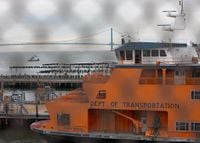On June 17, 2025, New York City took a significant stride towards sustainable transportation with the official transition of the Staten Island Ferry fleet to renewable diesel fuel. The Department of Transportation (NYC DOT) and the Department of Citywide Administrative Services (DCAS) jointly announced the arrival of the first barge delivery containing 336,000 gallons of hydrogenation-derived renewable diesel (HRD) at Staten Island, marking the beginning of a full replacement of petroleum-based diesel fuels for the iconic ferry system.
The Staten Island Ferry, which carries more than 45,000 New Yorkers daily and uses approximately 4.5 million gallons of fuel annually, will now operate on a cleaner, more sustainable fuel primarily made from waste materials such as used cooking oil and tallow. This shift aligns with New York City's ambitious goal to reduce greenhouse gas emissions by 50 percent by 2030, underscoring the city’s commitment to combating climate change through practical, large-scale initiatives.
Mayor Eric Adams hailed the transition as a modernization milestone for the ferry system, which he described as "one of the best ferry systems in the world." He emphasized the importance of powering the ferry with clean energy, stating, "The more than 45,000 New Yorkers who use the Staten Island Ferry each day will now travel powered by clean energy. This is just our latest effort on this front — our administration is laser-focused on making our entire city safer, cleaner, and greener every single day."
NYC DOT Commissioner Ydanis Rodriguez echoed the mayor’s enthusiasm, highlighting the ferry’s status as the busiest municipal ferry service in the country. He remarked, "Today's announcement offers a key step towards a cleaner and healthier New York City. When we all work together to green our transportation system, we can achieve our climate goals faster, showing the rest of the country how it can and should be done."
DCAS Commissioner Louis A. Molina further contextualized the achievement by noting that the city had already transitioned its heavy-duty and off-road vehicle fleets to renewable diesel. "Having successfully transitioned the city's heavy-duty and offroad fleet to renewable diesel, we have expanded its use to the Staten Island Ferry fleet, cutting emissions and proving that green transportation is achievable at a large scale," Molina said.
Keith Kerman, DCAS Deputy Commissioner and NYC Chief Fleet Officer, detailed the broader scope of the city’s renewable diesel adoption. "In the last three years, DCAS Fleet worked with each agency operating trucks to coordinate the transition to cleaner renewable diesel," he explained. "We are now doing the same with the city's vessel programs including at DOT, DEP, NYPD, FDNY, EDC, and Parks. By July 2026, all city trucks and vessels will use renewable diesel and be powered by used cooking oil and waste tallow."
The transition to renewable diesel for the ferry system was first announced in October 2024, when DCAS and NYC DOT began testing the fuel on the John J. Marchi ferryboat. Since then, the agencies have successfully used over 1.1 million gallons of renewable diesel across the ferry fleet. Inspections of internal engine components revealed that renewable diesel led to cleaner equipment with less carbon buildup compared to traditional diesel, showcasing an operational benefit alongside the environmental one.
In March 2025, DCAS finalized a new fuel contract for renewable diesel that references the Argus RD index price for New York Harbor, ensuring the fuel’s market alignment. This contract supports the city’s goal to fully transition all municipal vessels to renewable diesel by June 30, 2026.
Beyond the ferry system, DCAS is collaborating with other city agencies to expand renewable diesel use across marine operations. The Department of Environmental Protection (DEP), New York City Police Department (NYPD) Harbor Patrol, New York City Fire Department (FDNY), and NYC Parks Marinas are among those testing and integrating the cleaner fuel. To date, the city has consumed 27 million gallons of renewable diesel across its fleet, encompassing on-road vehicles, off-road equipment, and marine vessels.
DCAS also manages the largest electric vehicle (EV) fleet in New York State, boasting 5,500 EVs and 2,250 chargers. In June 2025, DCAS and FDNY unveiled the purchase of 30 all-electric vehicles, marking another significant investment in sustainable transportation and emission reduction.
Local leaders have welcomed the ferry’s transition to renewable diesel as a vital step toward environmental justice and community health. Councilmember Kamillah Hanks, representing Staten Island’s North Shore, described the ferry as "more than a mode of transportation—it is part of our identity." She added, "This transition to renewable diesel marks a monumental step toward cleaner air, a healthier harbor, and a greener future for Staten Island."
Assemblymember Charles D. Fall, also representing the North Shore, emphasized the ferry’s role in connecting residents to the city and improving quality of life. "Any improvements that enhance public health, safety, and quality of life for riders are a welcome investment in the well-being of our entire borough," he said.
Councilmember James Gennaro, Chair of the Committee on Environmental Protection, Resiliency & Waterfronts, praised the city’s leadership for setting a powerful example. "The transition of the Staten Island Ferry to 100 percent renewable diesel is a powerful testament to our climate goals and shows that New York City is leading by example on clean transportation," he stated.
This move to renewable diesel is not the first time the Staten Island Ferry has explored alternative fuels. In 2013, the Department of Transportation launched a pilot program converting one Austen Class ferry from diesel to liquefied natural gas, funded partly by a $2.34 million federal grant. The total cost of the conversion was approximately $3 million, reflecting the city’s ongoing commitment to innovative and cleaner energy sources for its transportation fleet.
As the city continues to invest in sustainable technologies, the Staten Island Ferry’s shift to renewable diesel stands as a landmark achievement. It reflects a broader vision of transforming New York City’s transportation infrastructure into a model of environmental responsibility and operational efficiency. By adopting fuel derived from waste products, the city not only cuts emissions but also promotes a circular economy, turning byproducts into valuable resources.
With the full transition underway and a goal to convert all municipal vessels by mid-2026, New York City is demonstrating how urban transit systems can evolve to meet the challenges of climate change while serving millions of residents daily. The Staten Island Ferry’s renewable diesel journey is a testament to the power of innovation, collaboration, and commitment to a greener future.




